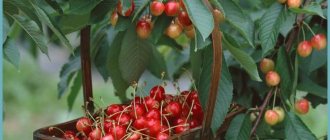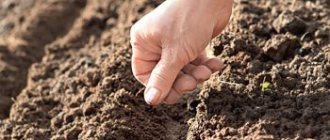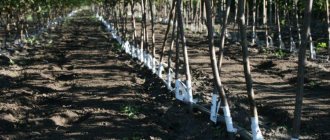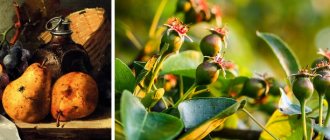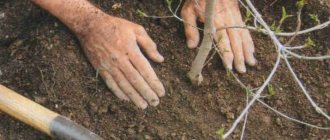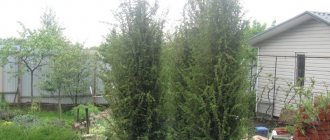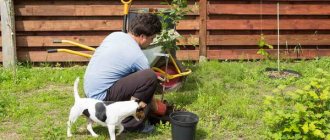Bush cherry - botanical description
- Bush cherry is also called steppe cherry or bush cherry. Belongs to the Pink family and the Cherry subgenus.
- Bush cherries are widespread in the territory from Central Europe to the mountainous regions of Altai. Prefers to grow in well-lit places and on carbonate soils.
- Bush cherry is considered one of the ancient ancestor species of the common cherry.
- Bush cherries do not exceed 2 meters in height.
- Despite the modest size of the bush, the root system of bush cherry is quite developed. The bush is abundantly surrounded by root shoots, which are a means of renewing the cherry.
- The crown of the bush cherry is spreading and spherical. In diameter it can reach from 90 cm to 150 cm.
- Young shoots of bush cherries are green, and as they grow they become brown or brownish-purple.
- Bush cherry leaves grow on petioles reaching 1.5 cm in length. The leaves are lanceolate, narrowed towards the base. The front side of the leaf is dark green, and the back side is light green.
- Snow-white flowers appear on bush cherries even before the leaves bloom or simultaneously with them. Flowers can grow singly, or they can be collected in groups of 2-4 in umbrella-shaped inflorescences.
- The fruit of the bush cherry is a rounded drupe, which reaches up to 2.5 cm in diameter. It has a sweet and sour taste. May have a red, pinkish or almost black tint. The fruits are suitable both for fresh consumption and for making jam, compote, jam, etc.
Growing cherries from pits at home
Growing cherries from pits is quite difficult. First of all, you need to select suitable seeds, rinse thoroughly with water and dry. After this, they are placed in water for a week, periodically changing the liquid (Figure 8).
Figure 8. The procedure for planting and growing a seedling from a seed
To obtain a seedling, the seeds are placed in a pot with soil and sand, covered and allowed to germinate for two months. With proper care and regular watering, a shoot will appear during this time and can be transplanted into open ground.
It is advisable to carry out the transplant in October. The seedling is planted in a shallow hole (only 3 cm), covered with a layer of mulch and left for the winter. It is worth considering that growing in this way will take quite a long time.
Advantages and disadvantages of bush cherries
Among the benefits of bush cherries are the following:
- bush cherry is very drought-resistant;
- Bush cherries have excellent frost-resistant characteristics. The shrub can withstand frosts down to minus 50 degrees;
- Bush cherries are valued by many gardeners for their decorative qualities. The bush is covered with flowers early and decorates the garden;
- Bush cherries are unpretentious to the soil and can grow in poor, rocky areas.
Among the disadvantages that are not so significant are the following:
- bush cherries will not grow well in a shady area;
- Bush cherry fruits are slightly inferior in taste to tree cherry varieties.
When to plant cherries in the fall: planting dates in different regions of Russia
Planting cherries in the fall is determined by the region where the tree is planned to be grown.
In the Moscow region, central Russia, and Belarus, planting work is carried out in September and early October. At this time, the weather is relatively warm and stable, the close rainy season promotes the rooting of seedlings and their strengthening.
In the Urals and Siberia, cold weather arrives earlier, so planting dates are set no later than September.
In the Leningrad region and St. Petersburg, cherry seedlings are planted in the first half of September.
In the southern regions, cherries are planted in October and even November, since weather conditions allow work to be carried out at this time.
On the day of planting cherry trees, the air temperature should be less than 12-15 degrees Celsius. The work is carried out on a quiet, windless and cloudy day without precipitation.
A good guide for determining planting work is the lunar calendar. According to his recommendations, in 2021 favorable days are September 19-26, October 3-13 and October 18-21.
It is not recommended to plant cherries on August 8,20,21,22, September 7,16,17,21, October 6,13,14,15,20, November 5,10,11,19.
Bush cherry - varieties
Bush cherry Generous
The Shchedraya variety is late-ripening and self-pollinating. The shrub can reach 2.5 meters in height, and the crown is 2 m in diameter. You can harvest cherries only in the 3rd year after planting. With proper care and comfortable conditions, the Shchedraya bush cherry variety will be able to bear fruit for 35 years. The advantage of this variety is that the fruits are quite large and are valued for their excellent taste characteristics.
Bush cherry Maksimovskaya
Steppe cherry of this variety can reach a height of up to 2.5 meters. The crown of the shrub has a slightly elongated shape and a medium degree of thickening. The fruits begin to ripen in the second half of July. The weight of one ripe cherry is about 4 grams. Among the disadvantages of this variety are relatively low resistance to fungal diseases and low frost resistance. Among the advantages of the Maksimovskaya variety, one can note its good tolerance to drought. Ripe cherries can be consumed both fresh and processed. If small storage or transportation of cherries is required, the fruits will tolerate this well. To pollinate this variety, partner varieties must grow on the site - Altai Lastochka, Zhelannaya, Subbotinskaya.
Ruby bush cherry
The bush reaches 2.5 meters in height, has a wide and spreading crown. The flowering period begins at the end of May, and the fruit ripens at the beginning of August. Cherry flowers are collected in small inflorescences of 2-4 pieces. The leaves have a shiny leathery surface and a dark green tint. The fruits can have different sizes, the average weight of a ripe fruit is 3.5 grams. Cherries have light yellow flesh with a sweet and sour pleasant taste. To pollinate cherries of this variety, cherries of other partner varieties (Vladimirskaya, Otechestvennaya) must necessarily grow on the site. Bush cherry Rubinovaya begins to bear fruit in the 2nd year after planting. One of the rather significant disadvantages of this variety is its low resistance to diseases.
Bush cherry Altai swallow
The bush cherry variety Altai Swallow has long earned the love of many gardeners. The undoubted advantages are high frost resistance and excellent taste characteristics of fruits that taste like cherries. The shrub reaches a height of only 150 cm. The crown is spreading and prone to thickening. Harvesting can be done in the second half of July. Ripe cherries are not stored for too long and do not tolerate long-term transportation.
Bush cherry Bolotovskaya
Late-ripening Bolotovskaya cherry has many advantages. Firstly, even a novice gardener can cope with growing this shrub. Secondly, cherries are not only frost-resistant, but also drought-resistant. With favorable growth conditions and proper care, it will be possible to harvest a tasty harvest within 30 years. The fruits are large, burgundy in color. In addition, the Bolotovskaya variety is a completely self-pollinating variety.
Bush cherry Subbotinskaya
Bush cherry Subbotinskaya is capable of reaching a height of 2.5 meters. The crown of the bush is very dense and spherical. Cherry blossoms bloom in a beautiful soft pink color. Flowers of 2-4 pieces are collected in small inflorescences. The leaves of the variety have a dark green color, lanceolate shape and a slightly jagged edge. A distinctive feature of bush cherries of this variety is the tendency of its crown to thicken. If you do not engage in crown formation, the shrub can become a “victim” of insect pests. With proper care, Subbotinskaya cherries produce a tasty harvest of fruits weighing up to 5 grams. You can collect up to 9 kg of cherries from one bush. Since the Subbotinskaya variety is self-sterile, it is recommended to plant it in the garden together with partner varieties: Altai Swallow, Zhelannaya, Selivertovskaya.
Bush cherry Vuzovskaya
This bush cherry variety was described in 1991. The crown of the bush has an oval shape and an average degree of thickening. The cherry reaches a maximum height of 150 cm, and the diameter of the crown is about 190 cm. The cherry blossoms with white flowers, which are collected several times in small inflorescences. The fruits of the Vuzovskaya bush cherry are dark red in color. The weight of one ripe fruit is only 1.5 grams. Some gardeners are convinced that the true flavor characteristics of cherries are revealed when they are processed. If you decide to plant steppe cherries of this variety on your site, you will be able to harvest in mid-July already in the 3rd year after planting. The Novoseletskaya variety is suitable as a partner variety for pollination.
Bush cherry Novoseletskaya
If you are looking for compact and early-fruiting cherries, then the Novoseletskaya variety will be a worthy choice. The shrub reaches only 115 cm in height and has a spreading crown. Dark red berries ripen on thin shoots. The average weight of one ripe fruit is 2 grams. You can start harvesting the first harvest in the second half of July. The ideal partner variety is the Irtyshskaya variety.
Bush Cherry Wild
Wild bush cherries served as the basis for the development of many modern varieties of steppe cherries. This shrub grows up to 2 meters in height. Its reproduction in the wild occurs with the help of root suckers, which surround the bush in large numbers. The fruits of this small-leaved shrub, although large, are quite sour.
Bush cherry Shadrinskaya
Shrubs of this variety are capable of reaching a height of up to 190 cm. The crown of the Shadrinskaya cherry is spherical and has an average degree of thickening. The bark has a brown tint with a gray coating. You can start harvesting in the second half of August. The weight of one ripe fruit is about 3 grams. With proper care and comfortable growing conditions, you can harvest up to 7 kg of tasty harvest from one bush. Among the disadvantages, it can be noted that cherries are quite difficult to transport.
How to trim an old cherry tree
Pruning of old bushes is carried out in the spring in order to rejuvenate the plant and return it to its former productivity.
To do this, it is worth reducing the number of shoots and shortening them by ½ or ⅓. In addition, remove skeletal branches before buds or developed lateral branches appear. Do not remove annual growths on an old tree.
Source: Depositphotos
Pruning will increase your yield
Rejuvenate the tree only when the skeletal branches are bare at the base, and annual growth reaches 15 cm. If the branches in the middle of the crown have dried out, cut off the branches on the side branches.
When trimming bush cherries, do not remove many branches at once. This is carried out in stages over several years.
Despite its high resistance to cold, bush cherries have many disadvantages and often get sick. But with proper care, the tree will produce a bountiful harvest of juicy berries.
Planting bush cherries
Choosing soil for planting bush cherries
One of the main advantages of most bush cherry varieties is their unpretentiousness to soil composition. If the soil on your site is not particularly fertile, this will not be an obstacle to growing steppe cherries. It is desirable that the soil has a neutral level of acidity, is loose and sandy loam.
Choosing a place to plant bush cherries
Where will bush cherries grow best? It is advisable to choose an elevated area or a site on a slope. Take into account the fact that close flow of groundwater to the surface of the earth will provoke rotting of the root system. The place should be well lit and protected from winds. You should not plant steppe cherries near tall trees or tall buildings that will create shade. If this cannot be avoided, then choose the south side for planting.
Preparing a planting hole for bush cherries and planting
- You should start planting bush cherries in the spring, when warm weather sets in and the earth warms up well. Bush cherry seedlings can be purchased at any specialized nursery that grows plants for sale.
- Dig a planting hole with approximate dimensions of 60*60*60. Some gardeners advise preparing the planting hole in the fall. If you are planting several bush cherry seedlings, then you need to leave a distance of up to 2.5 meters between them, since the crown size of some varieties exceeds 2 meters.
- A layer of humus is placed at the bottom of each planting hole at the rate of 4-5 kg per 1 sq.m.
- Some gardeners also enrich the soil with phosphorus or potassium fertilizers before planting.
- Bush cherry seedlings do not need any preparation. If you notice that the roots have dried out a little, you can place them in water for 4-5 hours.
- Once the planting hole is ready, you can begin planting. Place the seedling in the center of the hole, straighten the roots and begin to cover them with soil. Shake the seedling periodically so that the soil fills all the air spaces between the roots.
- After planting, the root collar should remain above the ground at a distance of 3-4 cm.
- Build a furrow for irrigation around the bush at a distance of 30 cm.
- Water bush cherries immediately after planting. After watering, the soil will shrink a little and you will have to fill it up a little so that the root collar does not rise too high above the ground.
- After watering, the tree trunk circle will definitely need to be mulched with humus or sawdust to reduce the rate of moisture evaporation.
Where is the best place to plant cherries on the site?
Regardless of the variety, it is better to plant the crop in an area with a slight elevation. If there is no such place, an artificial mound of soil is poured. This is necessary so that rainwater does not accumulate at the roots and cause them to rot.
In addition, these plants love sunlight, and although traditional varieties will tolerate some shade, it is best to plant in a well-lit area if possible.
The best place for planting will be an area near a house or fence. This way the tree will be protected from the cold wind, and additional accumulation of snow in winter will ensure the preservation of the crop.
Soil preparation
Before planting, it is necessary to prepare the soil. This will ensure good tree growth in the initial stages of cultivation and abundant fruiting in the future.
Organic fertilizers and mineral fertilizers are added to the soil. Acidic soils are additionally limed. It is advisable to prepare the holes in the fall if spring planting is planned. Fertilizers are also applied immediately before planting. However, in this case, do not use nitrogen-containing fertilizers, as they can cause burns to the roots.
Bush cherry - care
How to water bush cherries
Almost all varieties of bush cherries are drought-resistant. But you still need to water the bushes. For steppe cherries, 2-3 waterings per season with plenty of water (10 liters per bush) are enough. Gardeners usually combine these waterings with the application of fertilizers.
How to feed bush cherries
Bush cherries can easily do without fertilizers. But you can “pamper” your bushes with fertilizing during flowering and again after 14 days. You can prepare the following solution from 10 liters of water:
- 10 g urea,
- 15 grams of potassium chloride,
- 25 grams of superphosphate.
You can also prepare the following solution for feeding bush cherries:
- 50 liters of water;
- 1 kg of ash;
- 10 kg mullein.
Place half a bucket of the resulting solution under each plant.
How to protect bush cherries from diseases and pests
Like all fruit shrubs in the garden, steppe cherries can be attacked by pests or infected with various fungal or bacterial diseases. To avoid such troubles in growing bush cherries, you should adhere to the following rules:
- do not neglect the advice on choosing the optimal place for planting bush cherries. If you plant a plant in a low area, an area with close-flowing groundwater, or an area where the snow level exceeds 90 cm, the cherry root system may begin to rot;
- do not neglect advice on planting and caring for bush cherries. The watering regime is especially important, which should not be too frequent and abundant. Most bush cherry varieties are drought tolerant;
- in order to protect bush cherries from insect pests, it is useful to grow fragrant herbs (wormwood, mint, coltsfoot) near the bush;
- If you notice pinkish spots or plaque on the leaves, this may indicate infection with a rather dangerous fungal disease - coccomycosis. This fungus can completely destroy a plant, so you should not delay treatment. In the fight against coccomycosis, drugs such as Maxim and Horus have shown the greatest effectiveness. It is also very important to promptly remove damaged shoots, leaves, and destroy fallen leaves;
- Preventive treatment of steppe cherries with copper sulfate can protect the tree from many parasites.
How to prune bush cherries
All bush cherry varieties require pruning. It should be not only sanitary, but also formative and rejuvenating. Correctly carried out pruning of bush cherries will contribute to the formation of a beautiful crown, will protect the plant from diseases and pests, and increase fruiting. Some varieties require more severe pruning, as their crowns tend to thicken. If the crown is very dense, fruits will appear only on the side shoots. Let's consider the peculiarities of pruning bush cherries:
- In spring and autumn, sanitary pruning is carried out with the removal of all dry and damaged branches;
- Formative pruning should create a spreading bush shape of the cherry. You can start forming the crown after the first year after planting. At the base of the bush, branches should be located every 3-8 cm;
- After formative pruning, the bush cherry tree should have at least 5 main branches. Subsequently, shoots in the middle of the bush are removed, which only thicken the crown. In any case, when forming the crown of a bush cherry, you need to strive to create a spherical shape, which is not only more aesthetically pleasing, but also greatly facilitates plant care and harvesting;
- After about 6-7 years, bush cherries need to be rejuvenated using root suckers.
Any type of pruning of bush cherries should be carried out in the spring before the buds awaken or in the fall.
Bush cherries will add variety to your garden plot, and caring for this plant will not cause much trouble. All that bush cherries require is occasional watering and pruning. If all these simple requirements are met, the shrubs will produce abundant harvests for 30-35 years.
How to trim young cherries
Young bush cherries should be pruned immediately after planting. Thanks to this, you will form the correct shape and help the roots take root faster. In this case, pruning is carried out before the buds swell. After it there should be 5 strong and well-developed branches. The selected branches should grow in different directions and be at a distance of 10 cm from each other.
Remove all other branches and coat the cuts with varnish. Throughout the spring, ensure that thickening does not form and that the crown develops correctly.
Remove all branches that grow inside the bush, along with new shoots formed on the trunk.
As the bush grows, leave new skeletal branches until there are more than 15 of them. We advise you to carry out the procedure as carefully as possible - mistakes made will lead to a drop in yield in the future.
In autumn, young plants should not be pruned after the growing season - a weakened tree will not withstand frost.
Care instructions
Basic cherry care includes the following operations.
- Regular loosening of the soil in the tree trunk circle. After rains and watering, a crust may form on the surface of the earth, which blocks the access of oxygen to the roots.
- Feeding. During the season it is necessary to apply it 2-3 times. Superphosphates are added in the fall, and mineral supplements in the spring. You can use ash or onion peels for fertilizer.
- Weed control. To prevent the spread of viruses and pests, it is necessary to regularly weed the tree trunk circle, since aphids develop well on weeds.
- Watering. During the season, bush cherries need 2-3 waterings. The first must be done when flowers appear. The procedure must be repeated during the period of fruit development and before wintering.
- Spraying cherries with special preparations. All varieties of cherries are susceptible to pests, as well as coccomycosis. There are many drugs available to treat wood.
Planting and fertilizers
It should be carried out in an area with good lighting. Fruit trees do not develop well in the shade. In areas where heavy snowfalls are typical, steppe cherries should grow on small hills. High snow levels can cause the bark to rot during melting. Bush cherries of any variety can grow in all types of soil. Seedlings take root best in sandy loam.
During planting, it is necessary to add humus to the soil, as well as fertilizers containing potassium and phosphorus. The amount of humus should be 5-6 kg for one seedling. The tree is planted in early spring in warm weather. The soil should be slightly warmed by the sun. During the growing season, cherries need the addition of superphosphates.
Trimming
Bush cherry needs regular and timely pruning. This type of care allows for the correct formation of the crown, which simplifies the picking of berries and caring for the tree. Pruning should be done in spring and autumn. When removing branches, you need to take into account that in most varieties, berries appear only on last year's shoots. Flowering begins on annual branches along the entire length.
The first pruning should be done a year after planting. It is necessary to remove weak and dead branches, leaving only the strongest. The initial formation of the bush is also carried out. Removing excess branches allows you to improve the development of healthy parts of the tree, which will have a positive effect on the volume and quality of the fruit.
Basic rules for pruning bush cherries.
- Pruning twice a year. After the growing season and before it begins, it is necessary to remove dry and diseased branches. This will save the plants from aphids and fungal diseases.
- Rejuvenation by pruning healthy branches. This will allow the fruits to develop better and also cause new shoots to appear.
- The main skeleton should consist of 4-5 branches. A crown that is too thick is harmful to the plant.
- After 6-7 years, it is necessary to remove the old skeletal branches and grow new ones using root shoots. This will increase the number of new growths in the future.
- Stem shoots are used for rejuvenation. They will quickly restore the tree's crown.
Features of dwarf cherry
Dwarf cherry grows from 1 to 1.5 meters in height. Thin spreading branches give it the appearance of a bush. The leaves are small in size and shape; they grow no more than 5 cm and have a pointed end. The flowering period of dwarf cherries lasts from 2 to 3 weeks and, unlike traditional varieties, is accompanied by a rich aroma.
The berries of the dwarf tree can be from light to dark red, some varieties become almost black when ripe. The diameter of the fruit is on average 1 cm, and the average weight is no more than 5 g. A distinctive feature of low-growing trees is the early period of yield and its high yield. They can reach 10-12 kg, which is ensured by the density of the berries on the branches.
Recommended timing
You can plant cherries in the garden in spring or autumn. Each term has strengths and weaknesses.
in autumn
Autumn planting of cherries is carried out from the second half of September until the end of the next month. In each region, the choice of time for the planting procedure is influenced by climate features. Planting should be completed a month before the onset of the frosty period.
Usually at this time the daytime temperature is 10-15 degrees above zero, and at night the thermometer shows 1-2 degrees above zero. At this temperature, the tree takes root well and its root system develops normally.
Important! If the approximate calendar dates for planting have already arrived, and the temperature is above optimal limits, there is no need to plant cherries. It is better to wait another week until the required temperature is established.
Planting seedlings with a closed root system is possible throughout the warm period of the year, including in the fall.
Advantages and disadvantages of planting in autumn
| pros | Minuses |
|
|
Attention! If a cherry seedling is purchased in a container, it can be planted on any day of the warm period of the year, but no later than 30 days before the onset of frost.
in spring
Cherry planting dates in spring fall in the first 2 weeks of April with some differences:
- In the southern regions, planting is carried out at the junction of March and April;
- in the middle zone, work must be completed in mid-April;
- in Siberia, in the Urals - at the end of April.
Planting should be done when the soil has warmed up sufficiently and the buds have not yet bloomed. Trees planted at the optimal time take root better and become resistant to diseases and adverse weather conditions.
The main advantage of spring planting is that there is no risk of seedlings freezing.
However, the slightest delay in disembarkation will lead to undesirable consequences:
- the seedling will not take root well and will be sick for a long time;
- development will slow down.
This may affect the tree’s entry into fruiting and the level of yield.
In what year will cherries bear fruit after planting? If you follow the technology of preparatory work and planting procedures in full, the cherry tree will bloom for the first time and set fruit 3-4 years after planting.
Selection of seedlings
Choosing a seedling is not such a difficult task. The main thing is to pay close attention to the appearance and place of purchase. The right seedling determines how soon the tree will begin to bear fruit and in what quantity.
It is not recommended to buy planting material for stone fruit crops on the market or from hand. There is a risk of running into an old variety with small berries or a wild crop.
The best place to purchase seedlings is a nursery that values its name and reputation. But even in such places you can make a bad purchase. This will never happen if the buyer knows all the subtleties and characteristics that are inherent only in high-quality varietal planting material.
First of all, you need to know when to buy seedlings. Don't wait until spring. In autumn there is the richest selection of material for planting, and in March-April nurseries sell leftovers that were stored in unknown conditions. You can make a purchase in the spring when there is no place to store seedlings. This period also has its advantage - low price.
When inspecting seedlings, you need to pay attention to the following points:
- Tall specimens with a large number of shoots, with powerful-looking roots, take a long time to take root. It's all about the probably damaged root system during digging;
- annual varieties take root much better and faster;
- pay attention to the budding area, which is usually located at a height of 6-15 cm from the neck of the roots. This place should be slightly curved to the side; if this sign is not present, then it is most likely a seedling;
- high-quality one-year-olds have a height of 85-96 cm, two-year-olds - 2 meters. The exception is the Bystrinka variety, which after a year already grows to 1.5 meters;
- There should be at least 8 shoots on a standard annual seedling. Their length is from 10 to 20 cm. Two-year-old trees have shoots of 20-25 cm with branches with a total number of 12 or more;
- there should be no leaves.
Result: a seedling of one year of life is 1.5 meters long, it has a well-developed root lobe, and there are 2-4 branching shoots.
The health of a seedling is determined by the condition of both the roots and the above-ground parts. The shoots should not have growths or damage. A healthy root system is moist and free of suspicious formations.
To check the roots and shoots for dryness, roll the root into a ring. If you hear a crunching sound, then it is better to refuse the purchase immediately.
Before choosing a seedling, you need to find out the following information from the store:
- name and description of the variety;
- flowering and fruiting time;
- Are there any pollinating varieties and what are they called?
Transportation of seedlings is also an important point if there is a long journey to the planting site. To preserve the roots, you need to prepare a mash. It is a mixture of clay and soil in equal parts with water. The roots are dipped into this mixture, and then immediately dipped in sawdust, which will help retain moisture. Afterwards, the roots are wrapped in thick cellophane.
Agricultural technology: basic techniques
Caring for young seedlings is simple:
- loosening the soil;
- watering in hot weather;
- weeding.
The roots of the Malinovka cherry lie shallow, in the surface layers, so they loosen it carefully, trying not to touch the plant.
Water in hot weather and if there is not enough rainfall. After the leaves fall in the fall, they must be removed from the trees. The fallen leaves contain pathogens of fungal diseases that are dangerous for the Robin, so all the litter is destroyed. Also in the fall, it is advisable to very carefully dig up the soil in the circle of cherry trees.
Top dressing
Malinovka cherry does not require fertilizing during the period before fruiting begins (up to 4 years after planting). But only on the condition that during planting all the necessary nutrients were added to the pits, the area was fertilized.
Then, in the 4th year after planting, in the spring the cherries are fed with organic matter. To do this, dilute urea (20 grams per 10 liters of water), add the composition to the tree trunk circle. Instead of urea, use mullein or bird droppings (diluted 1:10 or 1:15), or simply rotted manure (3-5 kg per 1 square meter of tree trunk circle).
Fertilizing is repeated during the flowering period and the beginning of ovary formation. In the fall, potassium and phosphorus additives are added, for which superphosphate or wood ash are suitable. Fertilizers are sprinkled on the ground, then the soil is dug up.
ON A NOTE! In autumn, nitrogen compounds are not applied, as they stimulate shoot growth.
It is advisable to combine fertilizing with watering.
Watering
Water the Malinovka during the flowering period, when the fruits begin to form, as well as in the fall (after leaf fall). In dry weather, watering is carried out more often, while at the same time avoiding excessive waterlogging of the soil.
To preserve moisture, it is recommended to mulch the tree trunk circle. Peat, ephedra, and sawdust are suitable.
Trimming
A cherry tree is formed by pruning, thereby obtaining a crown of the correct shape. The seedlings are left with strong branches that will be skeletal, and all parallel and weak ones are cut out.
In the spring, diseased, frozen and deformed shoots are cut off, covering all cuts with varnish or a special ointment.
Spring pruning is carried out before the sap begins to flow, although dry branches can be cut as soon as the buds begin to swell.
In autumn, cherries need to prepare for wintering, and this is especially important for trees growing in regions of risky farming. Gardeners in the southern regions carry out work until November, but in the northern regions they will have to hurry up and have time to do the pruning at the end of August or beginning of September
IMPORTANT! Young seedlings are not pruned before the first winter, so as not to weaken them.
But we must remember that all cuts must have time to heal before the onset of cold weather. In mature trees, those shoots that interfere with others, as well as those that get out of the crown, are pruned.
The stumps are not left; during frosts, gum forms on them.
Subsequent care of the crop
Cherry trees are pruned in the spring, when the buds on the tree have not yet awakened. It is necessary to trim excess and damaged branches in order to form the crown, reduce the density inside the bush and to increase yield.
There is no need to cover the frost-resistant Shchedraya (Maksimovskaya) for the winter; you just need to provide protection for the branches from hares and other rodents, if such pests exist.
The first 2-3 years before the start of active fruiting, the plant does not require fertilizing. From the third year, the crop must be regularly fed with complex fertilizers and organic matter added annually.
